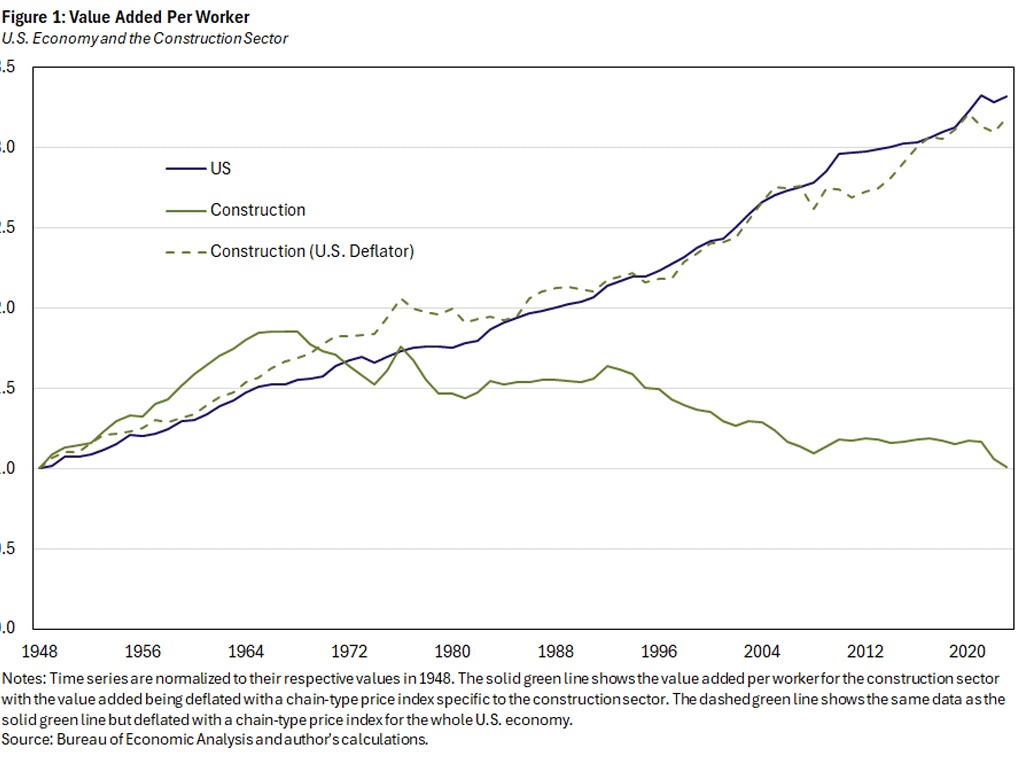Construction has been stuck in a productivity rut for decades. McKinsey’s research shows that while global construction output has grown just 0.4% per year between 2000 and 2022, the U.S. construction sector has actually seen productivity decline since the 1970s. Other industries doubled or tripled their output per worker over the same timeframe. In fact, studies show today’s output per U.S. construction worker is roughly the same as it was in the late 1940s and 1950s, while manufacturing has steadily grown about 3% annually.
This isn’t a blip it’s a structural, multi-decade issue. The question is why.

The Workforce Transformation
From 1990 to 2025, the U.S. construction workforce changed dramatically. In 1980, only about 6% of construction workers were Hispanic. By the early 2020s, roughly one-third were. About one in four construction workers today is foreign-born, and in certain trades, that figure is closer to one in three. CPWR surveys show that 37% of Hispanic workers speak English “not well” or “not at all,”. Most do not speak English at home.
This shift means many jobsites now operate across two languages: English for design documentation, specs, RFIs, codes, and coordination meetings; Spanish for a large share of the labor force. This is not a critique of workers who bring tremendous skill and dedication but rather a recognition of the communication challenge this creates.
Communication, Rework, and Delay
Communication breakdowns are costly. A major industry survey by Autodesk and FMI found that poor project data and miscommunication account for about 52% of all rework in U.S. construction roughly $31 billion per year in avoidable cost. Rework means lost time, blown budgets, and projects running off schedule.
When language gaps prevent instructions, RFIs, or change orders from landing clearly, small misunderstandings can snowball into miscut steel, misplaced formwork, or out-of-sequence pours. These errors feed directly into the 52% statistic. Sites with language divides often see higher incident risks and heavier coordination overhead. That drag isn’t about skill it’s the cost of translating critical information under pressure.
AE vs. Construction: The Misalignment
On the architecture and engineering side, communication remains overwhelmingly in English drawings, specs, submittals, BIM notes, coordination calls, code references, and shop drawing comments. On the field side, a significant share of foremen and crews primarily communicate in Spanish. The result is two parallel information streams on the same project. As the Spanish-speaking share of the workforce rose from the 1990s onward, that misalignment became a systemic interface problem: English-language information must be accurately and rapidly delivered in Spanish, often by people juggling multiple other duties.
Does This Explain the Productivity Stall?
Language alone does not explain construction’s decades-long productivity problem. The slowdown predates the 1990s demographic shift, and McKinsey highlights deeper structural issues: fragmented contracting, low standardization, underinvestment in technology and training, and regulatory frictions. Other forces are at play too skilled labor shortages as older workers retire, increased project complexity with advanced systems and sustainability requirements, and the stop-and-go cycles of boom and bust that prevent steady investment in innovation. All of these drag on productivity regardless of language. Still, language acts as a force multiplier for inefficiency. Once the workforce became truly bilingual at scale, every existing friction RFI latency, change management, safety, QA/QC got a little worse when teams didn’t explicitly manage multilingual communication. The key point is that while many factors contribute to the productivity stall, language is one of the more immediate and solvable ones.
What Good Looks Like (and Where Ferris Helps)
Closing this gap requires tools that meet the workforce where it is. Bilingual-by-default communication auto-translated RFIs, submittal comments, and task-level checklists ensures clarity from the office to the field. When change orders drop, Spanish summaries with callouts for affected trades can keep everyone aligned. QA/QC workflows that capture evidence and flag mismatches in both languages cut down on costly mistakes. These are the types of solutions Ferris is designed to provide.
The Takeaway
Construction productivity has stalled for decades. The workforce has become far more Hispanic, immigrant, and multilingual. Miscommunication drives 52% of rework, and language gaps are a clear contributor. They aren’t the only cause of stagnation, but they’re a material, solvable piece of the puzzle. Closing the communication loop doesn’t mean asking crews to work harder it means helping them work smarter and clearer, so every worker’s contribution, no matter their language, has maximum impact.
Sources: McKinsey Global Institute (2017; 2024 updates), U.S. BLS/ACS, CPWR, and the Autodesk/FMI rework study.
Note from the author: This analysis is about systems and communication, not worker capability. Spanish-speaking crews are the backbone of countless projects I’ve worked on. The point here is that misaligned information flows—often along language lines—can slow us all down. Tools like Ferris exist to close that gap.



Leave A Comment